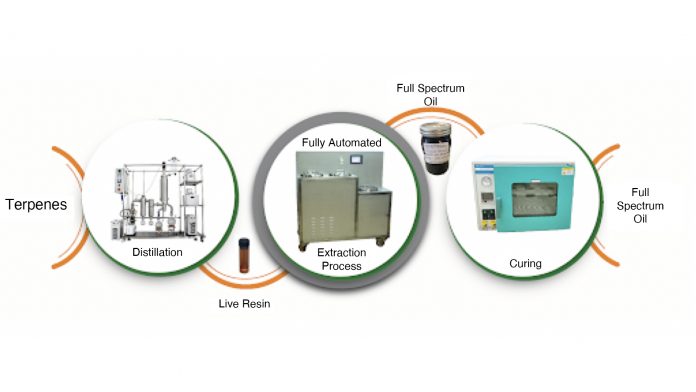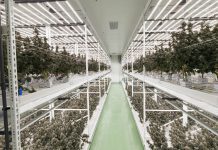
Pure5’s cannabis extraction technology is the best in the industry for the gentle production of live resin and full spectrum cannabinoids that maintain their medical qualities.
PURE5 Extraction has over a decade of experience in the cannabis processing market. Beginning with Rick Simpson Oil (RSO) before moving to clean distillates and eventually reaching the heights of live resin and expertly made bubble hash. For each of these oils, various technologies were used to produce different clarities of extract. PURE5 Extraction now has a clear understanding of the cannabis market and the future of CO2 and ethanol in cannabis extraction. The challenge now is to produce the best live resin, butter, and diamonds using hydrocarbon mixtures of butane, propane, and R134a.
The solubility of cannabinoids and other phytochemicals, as well as the consistency of the final product, are important factors that need to be considered when selecting a method of cannabis extraction. The viscosity of cannabis oil comes from binding various solvents together; therefore, it is important to consider the toxicity, affinity, and temperature profile of the solvent being used.
The efficiency of conventional cannabis extraction methods is also dependent on the choice of solvent. The solvents used to extract cannabis can be divided into three groups depending on their dielectric constant: non-polar, semi-polar and polar. These groups also define which volatile phytochemicals they can bring to the mix and how those should be dealt with.
The curing process
The curing process is highly important for the quality of cannabis oil. Curing is the final post-harvest procedure and is important in developing the maximum amount of flavour in cannabis. The best temperature and humidity for curing cannabis is 18 °C and 60% RH for 14 days. Trimmed cannabis flowers are traditionally kept in a can for up to four weeks in a dark environment while the lid is opened every day for around six hours.
At temperatures between 15–21°C and 45–55% humidity, enzymes and aerobic bacteria are at the optimum condition to break down undesired sugars and degrade minerals. Through curing, the unpleasant odour is eliminated; this also alleviates any throat irritation that may be caused by inhaling concentrates.
Curing can also extend the lifespan of cannabis products by reducing the likelihood of mould growth. Moreover, curing is needed to enhance the potency of cannabis by increasing the concentration of THC, CBN and other minor cannabinoids.
Solvent CO2 in cannabis extraction
Like other solvents, CO2 is a polar gas induced in a so-called supercritical state at a defined temperature and pressure. In that state, the supercritical CO2 behaves like a solvent, capable of extracting a broad range of non-polar and polar compounds, including cannabinoids. Furthermore, CO2 is not combustible, and it is harmless to living beings when in small doses it is also chemically stable, renewable, and easy to eliminate. It is also widely available and comparatively inexpensive.
The downside of CO2 extraction is its selectivity and the necessary post-processing with ethanol needed to winterise the oil obtained. Cannabis oil extracted using CO2 is often made up of over 40% phytochemicals, commonly referred to as waxes. The other disadvantage is grinding the material to fine powder, which requires strict filtering and filter maintenance. The entire process involves a lot of equipment and recovery.
Solvent Ethanol
Ethanol has been a universal solvent used to extract plant medicinals for centuries. Ethanol processing has emerged as the preferred method for many cultivators and processors due to its ability to efficiently extract a wide range of compounds while maintaining the integrity of the plant material.
The use of ethanol in the cannabis extraction process can result in the extraction of various cannabinoid derivatives, making it a suitable method for small-scale processors looking to create distilled products. It is also useful for large research facilities attempting to isolate significant amounts of particular cannabinoids like CBD and THC through distillation and crystallisation. However, ethanol extraction is not ideal for extracting terpenes due to its very low boiling point.
Another negative of ethanol extraction is that other phytochemicals, such as sugars, wax and lipids, are extracted alongside cannabinoids. To minimise this, cryogenic ethanol extraction is processed, where the solvent is chilled to -40°C to limit its solubility. This causes yield and expense to increase significantly. The other downside of the method is that solvent loss is over 10-20%, and the consistency of the recovered ethanol varies with each extraction, as does the end product.
Solvent Hydrocarbon
If you need to create fresh frozen flower cannabis resins, hydrocarbon extraction is an excellent option. The use of hydrocarbons (propane, butane) helps to extract the oils and terpenes from each strain, which is a combination of cannabis flavonoids, terpenes, and cannabinoids. When hydrocarbon extraction was first introduced, there was a great deal of interest in the products it could create, and it quickly became a popular extraction method.
Hydrocarbon extractors are generally cheaper than CO2 extractors. Hydrocarbon extraction is a suitable option for start-up businesses interested in creating derivatives in limited quantities due to its unique properties. A skilled lab technician can achieve cannabinoid concentrations of up to 80% at very high purities and can tailor butane and propane to create various specific marketable products.
The disadvantage of hydrocarbon extraction is the cost of installing the equipment. The equipment should be installed in so-called C1D1 rooms with special venting and explosive-proof designs. Also, the amount of hydrocarbons allowed on-site at the time is regulated, making it difficult to scale up production. Some states and countries banned the process due to increased incidents. Hydrocarbon should be designed as a closed-circuit system as the gas is extremely flammable and combustible, even if there is only a 6% presence in the air. Purging takes multiple days, and butane leaves a specific aftertaste in the products, which can be easily recognised.
Solventless extraction
In a search for perfection, well-established solventless methods such as dry-sifting, water extraction, and rosin press extraction are becoming increasingly popular. Dry sieve extraction produces a powder called Kief with a potency of approximately 35–50% THC. To extract trichomes from dried cannabis, the dry-sieving method involves striking the material against a mesh screen, causing the trichomes to separate and drop off.
The final product is pressed under high heat and pressure and converted to oil. While water extraction and solventless extraction are two methods for obtaining THC and CBD from cannabis, they each have their own limitations. Water extraction involves placing cannabis in a mesh bag and immersing it in ice water, then filtering the trichomes through screens and collecting the final product, known as water hash or bubble hash. However, this method is time-consuming and labour-intensive, and yields are low, making it difficult to scale up for industrial production.
Solventless extraction, such as rosin extraction, uses pressure and heat to extract the resin. Although it is possible to use a hair straightener for recreational extractions, a modified flat press is more commonly used for commercial applications. However, high pressure at low temperatures is difficult to achieve, limiting the retention of terpenes. To preserve terpenes, a pneumatic press exerts lower temperatures and higher pressures. Still, it is labour-intensive and not easy to scale while the yield is low, which is why the prices for rosin-pressed oils are high.
PURE5 Aerosol
Pure5’ aerosol solvent extraction method is a better option as it does not require exposure to materials. This method ensures that all cannabinoids and terpenes are extracted at room temperature, ensuring all vital plant enzymes and aerobic bacteria remain in place and the curing process can continue to break down underside sugars and minerals.
PURE5 offers gentle production of live resin and full spectrum oils, containing all medicinal benefits while keeping costs low. The cost of aerosol extraction offered by PURE5 is significantly lower than CO2, ethanol, hydrocarbon and even some bubble hash extractions. The extraction is done at room temperature, allowing all-natural compounds to separate and fully recover the solvent.
Any air is removed to avoid oxidation during the process. Then the aerosol gas is slightly pressurised and passed through the extraction vessel, where aerosol is collected in a recovery tank, leaving only full-spectrum cannabis oil in the collector. This extraction method is completely safe, non-flammable and non-toxic and not harmful to human health. It was approved by the FDA in 2001 and the European Union in 1996 and was certified as GRAS (Generally Recognised As Safe).
The extracts produced are extremely vital, rich in terpenes and cannabinoids, with a light colour. The extracts present an exceptional overall plant experience when used in cannabis products. PURE5 has received positive feedback on their oils and products for nine years.
PURE5 offers a complete process tutorial for creating unique raw materials for your infused products within 24 hours. You can fulfil your orders the same day with minimum time To Market. Due to the extremely safe and low-cost process, the lab can be set up with minimum compliance, allowing the production of exceptional raw products such as isolated terpenes, high-terpene live resin, high-terpene, full-spectrum oil, broad-spectrum oil, high-terpene distillate, high-terpene dab wax (diamonds) and butter with minimal investment.








